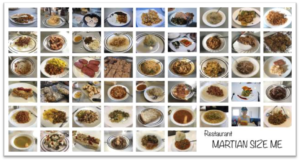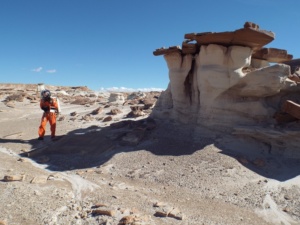30 Day Report
Hello from Mars,
火星からこんにちは (Kasei kara konnichiwa),
Привет с Марса (Privet s Marsa),
मंगल ग्रह से नमस्ते (Mangal grah se Namaste),
Salutations Martiennes,
We are 7 people living in the MDRS, (almost) operating as a manned Mars mission crew. We come from all over the world and enjoyed not only our high and down times in such small habitat. We share our cultures, our knowledge and our passion for the Red Planet.
This mission is about science and as such, scientists around the world support us. The overall program is ambitious, from geological morphology study to DNA analysis of microorganisms with unprecedented engineering projects and international outreach connection. The main idea behind the Mars 160 mission is to take the challenge of performing such a diverse program as it would be done on Mars…
Science
Scientific research on the Mars160 expedition is distributed program. The work carried out by the field crew is just the visible part a larger research team who identify the questions, design the experiments, supply the equipment, and advise the field team.
In 30 days, the field crew have performed 165 crew-hours of simulated EVAs, covering a large spectrum of objectives, from lichens sampling to landform investigations, geotechnical surveys and engineering maintenance. All EVAs are driven by the collaborative science program which focuses on the astrobiology aspect of Mars analogue environments – first in Utah and later on Devon Island during the second part of this mission planned for 2017. The two halves of the expedition allows us to compare similar microbial habitats and equivalent microbial communities in two different environments – the Arctic cold desert (FMARS) and the Utah hot desert (MDRS).
We are studying the Earth life form adapted to extreme conditions like temperature range, long term water deprivation, and intense ultraviolet bombardment. The most evident and easiest to find organisms are lichens. They are colonies of algae and fungi and have been found most often on rocks although few of them have been sampled from the soil and wooden structures.
We have searched for and found Hypolithic microorganisms on various sites. They are cyanobacteria or algae thriving in macroscopic colonies beneath or even inside transparent rocks. The experimentation starts on the field when statistical repartition is assessed. Yet, few of them are taken back to the station because most of the remaining process requires laboratory equipment that is still in transit between Earth and Mars.
Later on during this mission, halophiles – salt loving organism – will be searched for in gypsum crystals which have been found in high quantity on several places. Halophiles get stuck inside salt crystals when they formed during evaporite deposits. At MDRS the gypsum crystals are over hundred million years old, as are the living or fossilized halophiles we hope to find! Those at FMARS will be even older. We may also find modern halophiles lurking beneath salt crusts.
The link between all the biology science objectives is the environmental context including landforms, geological substrates and their history, and the local weather. Our crew has documented the various contexts with photographs, field drawings, and written notes. The data are returned to the station for further analysis. We expect landscape processes in the Arctic to be very different to those here, so it is important to understand the various processes both here and there.
Lichens are currently identified by color reaction to various chemical contact, a process called spot test. Later on the samples will be processed under a microscope so that the spores of the lichens can be observed to characterize them. The few hypolith samples brought back are photo documented, the rest is statistical processing. We expect to repeat this process when we are in the Arctic.
While we wait for the shipped laboratory equipment to land on Mars, the science team looks forward to the much more sophisticated analyses that will be done. The expectations are high. The advanced geological and biological experiments that are prepared will yield results, contributing towards the future astrobiological exploration of Mars!
Engineering
Every single resources and hardware here is limited (put aside the air). The engineering monitoring and maintenance is the key of our well-being if it is not our “survival”. For instance, we have already experienced shortage on water and will likely happen again before the end. Including flush, cleaning, hygiene, drinking and cooking no more than 8 gallons per person of water is used. We are focused on not wasting water. Our consumption would be even higher if not for the vacuum washing machine we have here. It just uses a fairly simple thermodynamic effect to kill bacteria without using high temperature, water as a solvent or even detergent or other fancy chemical. Just hard low pressure atmosphere which would be an unlimited resources on Mars and in space.
Since the last mission at MDRS – that was two years ago for half the crew – the station and its surrounding have changed quite a bit. Like a family, the old and devoted Hab, that already hosted over 1 000 people marks the landscape from its unique footprint and is now warmly surrounded by a few other old and new additions. The greenhouse is brand new, the solar arrays and the science dome give to the area a look of a Martian thriving base. Obviously the observatory is still here and now the whole is connected by tunnels. Inside the habitat, the furniture has been replaced to make the place cozier.
We are also enjoying newly designed spacesuits, heavier than the previous ones, but definitely more fitted to the harsh environment. The large possibility to tweak the fittings to each crew-member’s morphology and the airflow designed to prevent fogging are well appreciated improvements.
With the nice spacesuits, an interactive user interface is being developed. This project aims at improving EVA operations and field science but not only that, it should make EVAs more realistic and embedded to the work conducted in the station. The first prototype is now operational and will be tested during the next days. Soon, it will be integrated as a key component tool into the field science.
Outreach
Unlike the great exploration story of the past century, the intrinsic isolation that comes with exploring Mars does not prevent us to communicate with Earth-based teams and those we left back at home. Internet is our only – and limited – communication channel through which go our reports, pictures, videos and messages to our loved ones. We are not alone!
Our priority is to keep the base operational and the crew healthy. Consequently, our reports to mission-support are the main communication basis. Then the outreach goes mainly with the daily posts that everyone on Earth can access to, on the Mars 160 mission website. Not only that, articles are published weekly on Space.com, some crew-members write for their respective national media or respond to email interviews and we spend some time on the various social media as well. Lastly, our private messages complete the news that our relatives get from us. While we are used to live in hyper-connected societies, not having direct communications is a strange feeling. We do not feel the pressure of common society but the pressure of our Earth-based remote science team. Still, we are our only masters here and time flies both fast and peacefully…
Life
As the work progresses, one rule should never been forgotten. Safety first! As it would be on Mars. The start of the mission has been punctuated by various training such as ATV driving – that some of us has not driven for several years or even never drove before.
Inside the station it is pretty much like living in half garage (downstairs) and half submarine quarters (upstairs). As we live in a remote place we still must be careful regarding the inherent hazards of such a lifestyle. Even though, despite the dangers and the workload, individual health interviews show that the health and the morale of the crew is quite good. Over here, we keep the form and the good spirit thanks to the large variety of the food recipes, physical activities and leisure times.
The food is dehydrated or canned. It is just a habit to take before being quite comfortable to cook it. We take pleasure to cook every meal as cultural diversity entertainment. This is Martian food: Martian-French, Martian-Aussie, Martian-Canadian, Martian-Russian, Martian-Indian, Marian-Japanese, which restaurant do you like best?
Part of the crew is fond of yoga, done almost every day downstairs, to keep shape and flexibility. We also have improvised some workout equipments such as a pull-ups bar and a climbing rope. Some should end this mission with more physical abilities than when they started.
Our last social entertainment activity is watching TV shows episode and one movie during weekend evenings. Sunday is the day-off during which each crew-member is free to have leisure time. Usually this day is really enjoyed since the rest of the week is spent on working.
Life on Mars is hard. The work would be already challenging without the constraints of the simulation. Despite the difficulties of living a constrained life, the current Mars 160 crew is performing an unprecedented science, engineering and outreach program. But we are here because we all believe that a human to Mars mission is much more than hard work in difficult circumstances.
Hopefully, when it is stressed, the human mind enjoys little things. A beautiful sunrise on the desert, the smell of the coffee, a familiar music or a relative picture. These little things have the power to transport you to the other side of the world or back in time. Besides, the odds have bounded the crew with strong empathy for each other and friendship. Actually, life on Mars makes you feel human.























